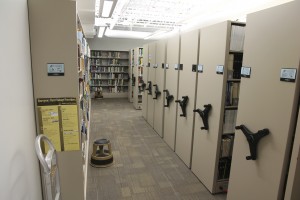
This post was written by David Edelmann, Smithsonian Environmental Research Center Library intern.
As an intern for the SERC (Smithsonian Environmental Research Center) Library, working under SERC librarian, Sue Zwicker, I was tasked with tackling a review of the Library’s Chesapeakiana Collection. The goals of the project were to:
- Create a bibliographic spreadsheet organizing all of the titles,
- Research each individual title for digital copies on the internet,
- Save and organize any accessible digital media found through research,
- Create a publicly accessible database of the catalogue with links to available digital copies,
- Assess items for scanning if they are not already available in digital format
The Smithsonian Environmental Research Center (SERC) is a research center in Edgewater Maryland, operated by the Smithsonian Institution. SERC covers 2,650 acres on the shore of Chesapeake Bay. SERC scientists have produced 2,400 scientific publications, and are national and international experts in watershed research, mangrove forests, wetlands and riparian ecosystems, and other fields of study. Several long-term environmental data sets have been produced at SERC, including the longest record of acid rain and its chemical impacts in the mid-Atlantic region, a 26-year database on species composition and population dynamics of plants and animals in the Chesapeake Bay, the world’s longest running field experiment on atmospheric increase in CO2 affecting plant communities, and the world’s longest data record on the increase in ultraviolet (UVB) solar radiation impacting the Earth.

The SERC Library is housed in the Matthias Laboratory, and is composed of approximately 12,600 books, monographs, and academic journals. The Chesapeakiana collection at the SERC library is comprised of monographic materials—including a substantial percentage of grey literature— related to the Chesapeake Bay and its surrounding areas. There is no designation in the SIL catalog to indicate that items are part of this collection. There are 489 titles in the collection: many of these titles are government documents and in the public domain.
The first half of my project was completed at SERC, which involved pulling information from each title out of the catalog and then exporting the data to Microsoft Excel. Those titles without barcodes were individually researched and organized at the end of the Excel sheet. After all 489 titles were added to the spreadsheet, I began researching the titles individually.
Working downtown at NMNH (National Museum of Natural History), I searched Google, University and other academic networks, and subscription and governmental databases for accessible digital copies of the titles in the Chesapeakiana collection. I found .pdf copies of 144 titles, and saved them each to a hard drive. I included the Bib No. for each item as part of the title of the saved copy.
The spreadsheet that I created includes detailed information for each title such as whether the title can be accessed via the internet, if it has a WorldCat entry, if the document is available in academic networks, if there is availability in the public domain, and finally the URL to the document online. In some cases there are multiple versions of a text, and in the “Notes” section there are explanations provided as to how to access the various versions.
Smithsonian Libraries does not yet have a standard mechanism for serving documents that are not published by Smithsonian authors, so, in addition to saving all the documents to an SI hard drive, I saved the documents and the spreadsheet to a dedicated Google account, along with a “how-to” guide. Digital Projects Librarian, Keri Thompson, and I discussed establishing links from SIRIS (Smithsonian Institution Research Information System) to the digitized documents. It is possible that the information I gathered might also be made public via Zotero, or another publicly accessible website or tool. As for now, the entirety of the project is housed on the Google Drive and also on the Smithsonian Intranet. Access for the public is pending a review of any potential copyright issues.
This project has resulted in a record of the items that are contained in the Chesapeakiana collection, and information on accessing electronic copies of 25 percent of this important collection. I am incredibly grateful that this project allowed me to fine tune my research skills, learn about the duties of librarians, and explore the vast knowledge within the Smithsonian Institution.

One Comment
Perhaps you may be interested in presenting a review of your project during GL16, Sixteenth International Conference on Grey Literature, Library of Congress on 8-9 December 2014
http://www.textrelease.com